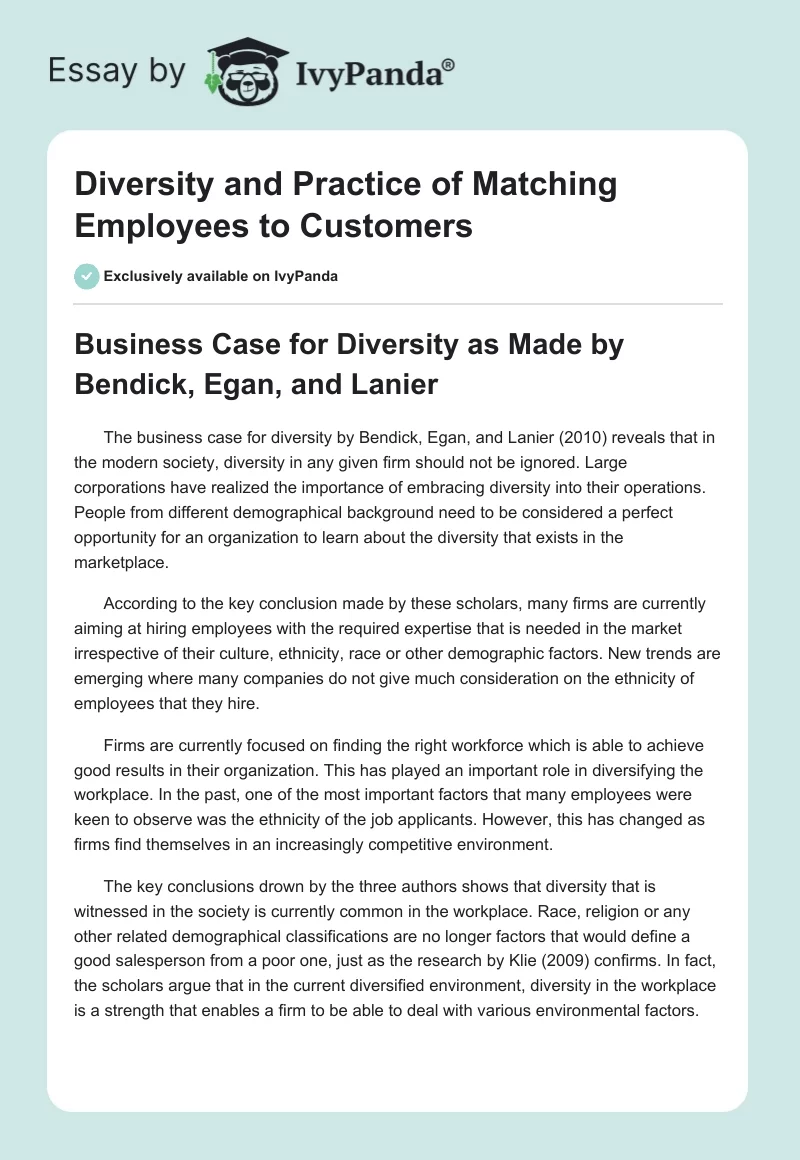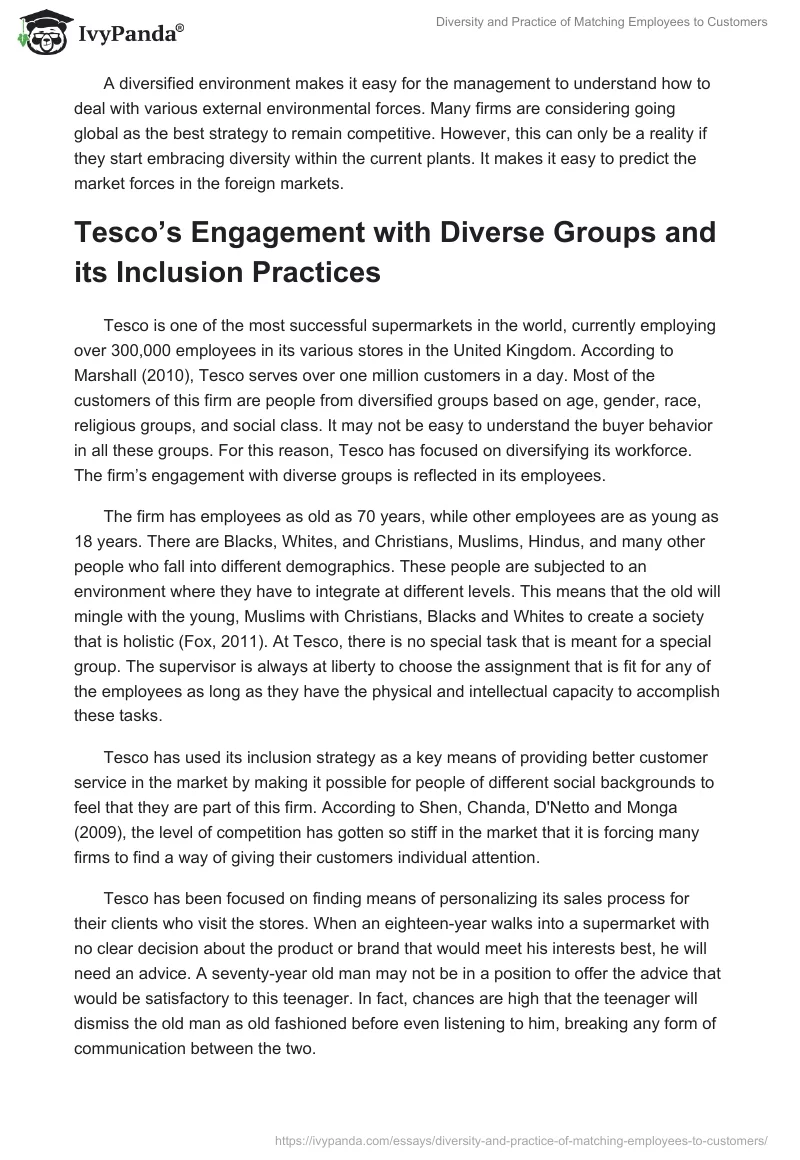Business Case for Diversity as Made by Bendick, Egan, and Lanier
The business case for diversity by Bendick, Egan, and Lanier (2010) reveals that in the modern society, diversity in any given firm should not be ignored. Large corporations have realized the importance of embracing diversity into their operations. People from different demographical background need to be considered a perfect opportunity for an organization to learn about the diversity that exists in the marketplace.
According to the key conclusion made by these scholars, many firms are currently aiming at hiring employees with the required expertise that is needed in the market irrespective of their culture, ethnicity, race or other demographic factors. New trends are emerging where many companies do not give much consideration on the ethnicity of employees that they hire.
Firms are currently focused on finding the right workforce which is able to achieve good results in their organization. This has played an important role in diversifying the workplace. In the past, one of the most important factors that many employees were keen to observe was the ethnicity of the job applicants. However, this has changed as firms find themselves in an increasingly competitive environment.
The key conclusions drown by the three authors shows that diversity that is witnessed in the society is currently common in the workplace. Race, religion or any other related demographical classifications are no longer factors that would define a good salesperson from a poor one, just as the research by Klie (2009) confirms. In fact, the scholars argue that in the current diversified environment, diversity in the workplace is a strength that enables a firm to be able to deal with various environmental factors.
A diversified environment makes it easy for the management to understand how to deal with various external environmental forces. Many firms are considering going global as the best strategy to remain competitive. However, this can only be a reality if they start embracing diversity within the current plants. It makes it easy to predict the market forces in the foreign markets.
Tesco’s Engagement with Diverse Groups and its Inclusion Practices
Tesco is one of the most successful supermarkets in the world, currently employing over 300,000 employees in its various stores in the United Kingdom. According to Marshall (2010), Tesco serves over one million customers in a day. Most of the customers of this firm are people from diversified groups based on age, gender, race, religious groups, and social class. It may not be easy to understand the buyer behavior in all these groups. For this reason, Tesco has focused on diversifying its workforce. The firm’s engagement with diverse groups is reflected in its employees.
The firm has employees as old as 70 years, while other employees are as young as 18 years. There are Blacks, Whites, and Christians, Muslims, Hindus, and many other people who fall into different demographics. These people are subjected to an environment where they have to integrate at different levels. This means that the old will mingle with the young, Muslims with Christians, Blacks and Whites to create a society that is holistic (Fox, 2011). At Tesco, there is no special task that is meant for a special group. The supervisor is always at liberty to choose the assignment that is fit for any of the employees as long as they have the physical and intellectual capacity to accomplish these tasks.
Tesco has used its inclusion strategy as a key means of providing better customer service in the market by making it possible for people of different social backgrounds to feel that they are part of this firm. According to Shen, Chanda, D’Netto and Monga (2009), the level of competition has gotten so stiff in the market that it is forcing many firms to find a way of giving their customers individual attention.
Tesco has been focused on finding means of personalizing its sales process for their clients who visit the stores. When an eighteen-year walks into a supermarket with no clear decision about the product or brand that would meet his interests best, he will need an advice. A seventy-year old man may not be in a position to offer the advice that would be satisfactory to this teenager. In fact, chances are high that the teenager will dismiss the old man as old fashioned before even listening to him, breaking any form of communication between the two.
With this in mind, Tesco has employed young attendants who can integrate with the customers in an effective manner. Similarly, an eighty-year old woman may not confide in a thirty-year man about a given product that she desires. She needs a seventy-year old lady who will be able to appreciate the reason behind purchasing a given product. This is one of the main reasons why the firm employs the aging population.
The approach taken by Tesco is strategically advantageous because it enables the firm to appeal to people from different backgrounds. This firm has been able to create an environment where every customer will feel comfortable with. Customers can easily find attendants they can associate with, and this makes it easy to ask for guidance. This creates a feeling among the customers that they are receiving personalized services from this firm, making it become very popular.
Comparing and Contrasting Tesco’s Approach to Inclusion and Diversity with the Key Conclusions Drawn by Bendick, Egan, and Lanier
Tesco’s approach to inclusion and diversity compares closely with the key conclusions drawn by Bendick, Egan, and Lanier (2010). One of the common factors between the two is that when dealing with diversity, it is important to look at it from a holistic point of view. It is not enough to hire people of different ages, or just different races. When approaching the issue of diversity, it is important to identify all the demographics within a given setting, and ensure that people falling under these demographics are effectively represented within the firm.
Another common factor is that diversity should be treated as strength other than a weakness. It offers a firm an opportunity to understand the diversity that exists in the marketplace. If diversity in the workplace can be managed, then it can be easy to manage the diversity in the market. It is important to note that there are some differences that exist between the approach taken by Tesco, and that given by the three scholars. One such clear difference is in the manner of assigning employees of different demographics various tasks.
While Tesco prefers assigning any employee any task as long as they have the physical and intellectual capacity, the three scholars propose and more defined approach when assigning tasks to different groups. Tesco’s inclusion and diversity strategy’s strength lies in the fact that it demystifies the notion that some groups of people cannot address some tasks. It also makes customers of different demographics to feel comfortable within its facilities. However, its weakness lies in the fact that sometimes employees are assigned tasks within their capacity, limiting their output. This may affect the overall performance of the firm if measures are not taken to address it.
References
Bendick, M., Egan, M.L., & Lanier, L. (2010).The business case for diversity and the perverse practice of matching employees to customers. Personnel Review, 39(4), 468-486.
Fox, A. (2011). Mixing it up. HR Magazine, 56(5), 22-27.
Klie, S. (2009). Diversity makes employers more attractive to candidates. Canadian HR Reporter, 22(8), 20-24.
Marshall, P. (2010).Taking action on diversity. The Canadian Manager, 35(1), 17-183.
Shen, J., Chanda, A., D’Netto, B., &Monga, M. (2009). Managing diversity through human resource management: an international perspective and conceptual framework. International Journal of Human Resource Management, 20(2), 235-251.


